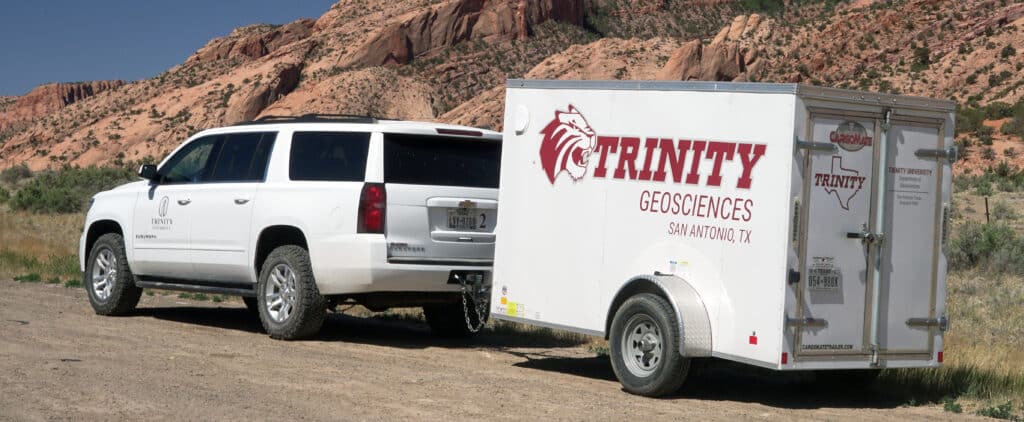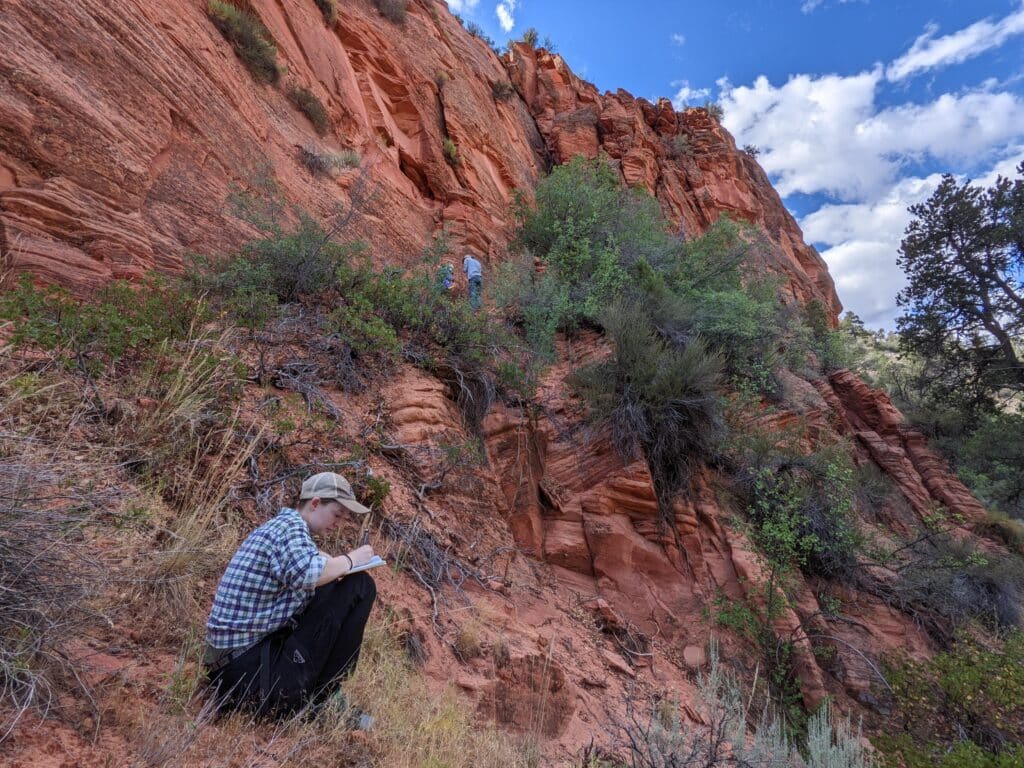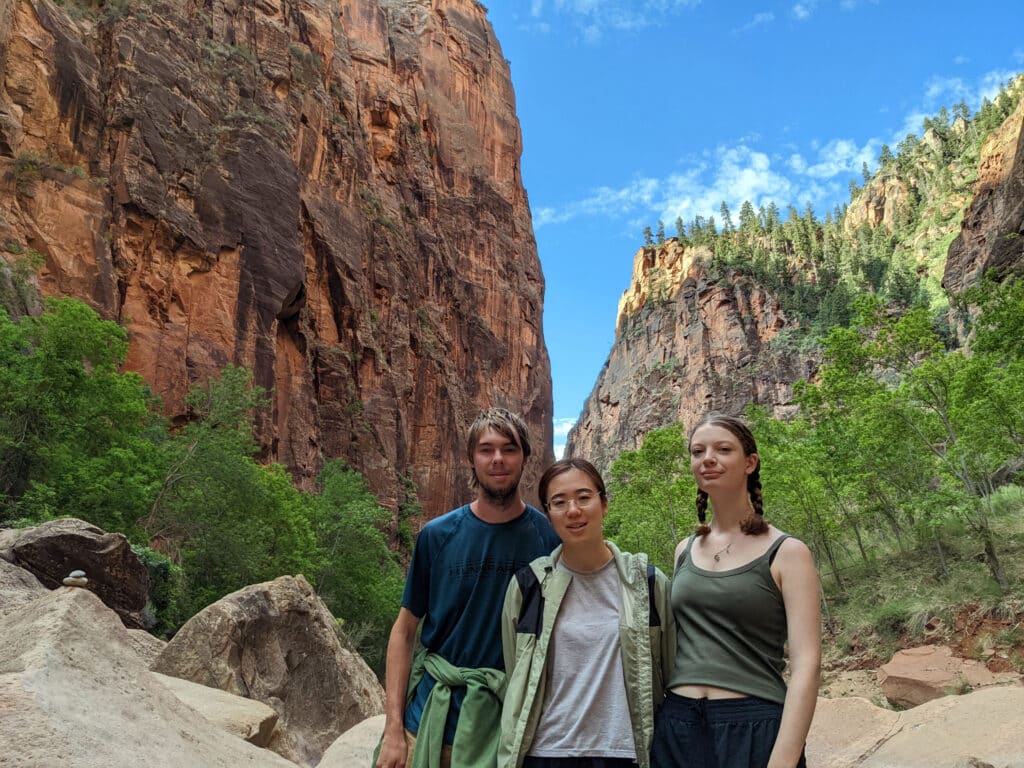Michelle, Audrey, and Jasper (from left to right) reclining on the (cross)beds of the Navajo Sandstone.
Submitted by Ben Surpless (Trinity University)
What a summer! As the summer research season ends and the new school year begins, I thought I’d catch everyone up on the exciting (but not-so-smooth) arc of our Keck Geology Consortium Advanced Project. I worked with three students to explore how major fault systems affect the rocks around them, which has implications for groundwater flow and geothermal energy potential adjacent to faults worldwide. In the case of the Sevier fault in southern Utah, fault segments have systematically fractured huge rock outcrops of the spectacular, cross-bedded Jurassic Navajo Sandstone, leaving evidence of past earthquakes and tectonic stress fields. Michelle Nishimoto (Wellesley College), Audrey Jennings (Trinity University), Jasper Neath (Trinity University), and I experienced the trials, tribulations, and successes of research in the field and lab, including abruptly pivoting our research trajectory due to COVID.
Prepping for the Project
Leading into the start of our in-person project near the end of the spring, students and I used Zoom to talk about a wide range of topics, including food preferences, camping logistics, computer modeling software, and students’ prior experiences in the geosciences. We discussed what excited them about our research as well as what challenges they anticipated. By the time the in-person project was set to begin, I think all of us were eager to meet face-to-face and jump into our research. Then this happened:

Yup. Just 2 days before students arrived on the Trinity University campus to start the in-person project, the Project Director (me) tested positive for COVID. Luckily, Michelle, Audrey, and Jasper stayed upbeat and flexible as we maneuvered through Zoom discussions, field planning, and literature review while I operated from my bedroom base (isolating from my family). However, the geology gods were with us, and I recovered quickly, testing negative on the first day I could leave isolation, so all geology systems were go!
Vamanos!

We departed the next day, traveling the 1,206 miles from Trinity’s campus to Bauer’s Canyon Ranch and RV Park in Glendale, Utah, which was our base throughout our time in the field. Our travel to Utah was smooth, with no issues en route. Although COVID delayed our departure, the extra prep time gave students more time to prepare for the science as well as for the challenges of fieldwork. To be fair, while doing fieldwork, we stayed at a campground with showers, laundry, Wi-Fi, and power outlets, so we were, in essence, geo-glamping.
Science on the Outcrop
During our time in the field, students and I documented rock deformation using sketches, photos, notes, and measurements, flew drone missions to gather data from inaccessible outcrops, and spent a lot (lot) of time on the outcrop discussing hypotheses to explain what we saw. Our data clearly showed variations in fracture intensity and orientation that we could relate to our position relative to the faults that cut through the study area. Some field days were tough, both mentally and physically, but we tried to get into the field as the sun was rising so that we were finishing up before the hottest part of the day was upon us. However, when we did get tired, we could always take a quick nap on the (cross)beds.

Midway through our time in Utah, we visited Zion National Park, admiring the stunning fracture networks exposed along the steep canyons that cut through the Navajo Sandstone. While there, we visited the Narrows, perhaps the best-known site in the National Park, and we took time to talk about a range of topics, building on our campground and field conversations. Pickleball tournaments, anime, soccer, and variations in life at different colleges were common topics throughout our time together.
As we wrapped up our time in Utah, we began to consider how me might use all that we had learned to develop Michelle’s, Audrey’s, and Jasper’s projects. Although we had collected a huge volume of data in the field, we began developing separate projects that leveraged field-based data to build hypotheses that students could be test with 3D computer modeling. During our drive back to Trinity, we began to flesh out frameworks that would work for each student, and we began talking a bit more broadly about the future – what comes after graduation?

Science in the Lab
Once back on campus and in the dorms, Michelle, Audrey, and Jasper dove into different types of computer modeling. Each of them spent most of the first few days developing modeling protocols that would be the foundation of their modeling efforts. Michelle used the drone-based imagery to build 3D virtual outcrop models for spatially-accurate quantitative analysis, and Audrey began building fault geometries that she could use to deform mechanically-accurate strata. With these models, Audrey can analyze the 3D stress and strain fields around the faults and compare her results to real-world fracture network characteristics. Jasper focused on building a 3D model of the entire fault network in order to validate ours and past researchers’ sub-surface fault interpretations.
In our last week, we all wrote abstracts for Geological Society of America presentations at the fall annual meeting in Denver (GSA Connects 2022). Because Michelle, Audrey, and Jasper had never written geologic abstracts, they wrote and revised their abstracts over several days while moving their modeling forward. Although their research results were preliminary as they wrote their abstracts, I helped them think through those results carefully in order to consider the implications of those initial findings (which are soooo cool – if you’re at GSA Connects, stop by and talk with them!). I also am presenting research related to the students’ projects, and like the conceptual relationships between their projects, I can see how all of our efforts will build toward broad, applicable conclusions that might impact energy resources in similar settings.
As the in-person portion of the project came to an end, we outlined what the next academic year might look like for all three students, and we discussed how their projects related to each other. It was invigorating to see each student’s progress and potential – although our project started with a minor derailment (aka COVID), I think all three students finished with a strong sense of accomplishment and excitement for what’s next.
So, what’s next?
I’m now at Trinity, sitting in my office on a quiet campus, prepping for the new school year. Michelle, Audrey, and Jasper are back home, getting ready to return to their campuses and likely considering what their projects will look like during the school year. As they work toward their research goals, each will deal with a range challenges, but I think that our collaborative work during the summer should provide a model they can use to support each other, in spite of the distances between them. I look forward to an in-person reunion in Denver, when they’ll present their research progress to the broader geological community, and we’ll talk again about life, research, and the future.

